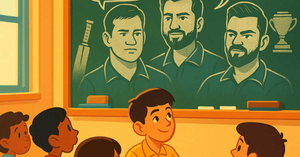Artificial Intelligence, specifically those chatbots and virtual assistants popping up all over the place (think ChatGPT and its cousins). The big question on everyone's mind is: what does this mean for our classrooms? Can these smart tools actually help kids learn better, or are they just the latest distraction?
It's time we unpacked AI in Classrooms: Can Chatbots and Virtual Assistants Enhance Student Learning? – looking at the exciting possibilities and the stuff we need to be careful about.
What's the Big Idea? How Could AI Help?
1. Personalized Tutor Power
AI can analyze a student’s learning style, strengths, and weaknesses, creating a customized curriculum that suits their pace and preferences. Instead of a one-size-fits-all approach, AI-powered platforms like adaptive learning systems can provide targeted lessons, quizzes, and feedback to help students improve in specific areas. Whether a student needs extra practice in math or a more advanced reading challenge, AI ensures that learning is tailored to individual needs.
2. Giving Teachers a Breather
Teachers often juggle lesson planning, grading, and student engagement, leaving little time for one-on-one support. AI can automate administrative tasks like grading assignments, tracking student progress, and even answering frequently asked questions. This allows educators to focus on what truly matters—mentoring, inspiring, and guiding students. AI can serve as a teaching assistant, freeing up valuable time for meaningful human interaction in the classroom.
3. Making Learning More Engaging
Traditional lectures and textbooks can sometimes feel monotonous. AI-powered tools can bring subjects to life through interactive simulations, gamified lessons, and immersive experiences like virtual reality (VR) field trips. Imagine history lessons where students can "visit" ancient civilizations or science classes where they can conduct virtual lab experiments. By making learning fun and interactive, AI can increase student motivation and retention.
4. Boosting Accessibility
Education should be accessible to everyone, regardless of location, learning disabilities, or financial constraints. AI can bridge gaps by offering voice-to-text features, real-time translation, and AI tutors that help students with special needs. Remote learning powered by AI can ensure quality education reaches students in rural areas or those who cannot attend traditional classrooms.
What Are the Red Flags?
This all sounds pretty shiny, but let's not get carried away. There are some serious things we need to think about:
- Thinking Skills vs. Copy-Pasting: If AI can write an essay or solve any problem instantly, will kids learn to think critically, problem-solve, or even write for themselves? The risk of over-reliance and plagiarism is huge. Are we teaching them to use a tool or just find a shortcut?
- Is the AI Always Right? (Spoiler: No): These tools make mistakes. They can generate incorrect information or reflect biases from the data they were trained on. Students (and teachers!) need sharp critical thinking skills to evaluate what the AI spits out. Blind trust is dangerous.
- The Access Gap (The Digital Divide): Cool AI tools don't help much if you don't have a reliable device and decent internet access. In a place like India, where access varies wildly, could AI actually make educational inequality worse?
- Who's Watching? (Data Privacy): When students interact with AI, they generate data. Where does it go? Who owns it? How is it being used? These are massive privacy and security questions that need clear answers.
- Losing the Human Touch: Can an algorithm replace the encouragement, empathy, mentorship, and inspiration a good teacher provides? Learning isn't just about information transfer; it's deeply human. We risk making it too cold and transactional.
- Are Teachers Ready?: Just dropping AI into a classroom won't work. Teachers need proper training and ongoing support to figure out how to use these tools effectively and ethically.
Finding the Smart Path Forward
So, it's not about AI being inherently "good" or "bad" for learning. It's about how we use it. The goal shouldn't be to replace teachers but to augment their abilities and support students.
Maybe AI is best used for:
- Providing endless practice opportunities.
- Giving quick feedback on basic skills.
- Acting as a starting point for research (that students then verify).
- Automating tedious administrative tasks for teachers.
Crucially, we need to double down on teaching digital literacy: how to ask the right questions, evaluate sources (including AI), think critically, and use these powerful tools responsibly.
The Bottom Line
AI tools like chatbots and virtual assistants definitely have the potential to shake up education in interesting ways, offering personalized support and maybe making learning more dynamic. But the potential pitfalls – from killing critical thinking to widening equity gaps and privacy concerns – are very real.
As we stand here in early 2025, AI is already knocking on the classroom door (if not already inside). The challenge isn't stopping it but guiding it. We need thoughtful planning, ethical guidelines, teacher training, and a constant focus on ensuring technology serves genuine learning and human connection rather than undermining them. It’s a tricky balancing act, but one we absolutely need to get right








Be the first one to comment on this story.